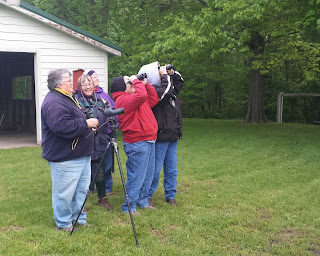Saturday, May 14th, dawned chilly and
windy as Jefferson County Naturalist, Therese Cummiskey, led an
educational birding event with Friends of Shimek State Forest. The
event was held at the Croton Civil War Memorial Park from 7:30am to
9:30am, near the Croton Unit of Shimek State Forest. The Croton Unit
of Shimek Forest is known state-wide as one of Iowa's premier birding
locations. Three children and 6 adults participated and learned
about binoculars and identifying birds by their physical
characteristics, flight characteristics, behavior, habitat and songs.
Therese has been a naturalist for over
30 years but a couple of years ago watched a movie called The Big
Year (2011) that inspired her to spend a year observing and recording
her own list of birds which included 240 different species in the
first year. She was hooked as she found birding to be a hobby she
could do anywhere.
 |
| Therese Cummiskey (left) uses her spotting scope to help participants find and identify birds. (Photo by Scott Chamberlain) |
Participants saw a wonderful variety of
birds including bluebirds, cardinals, robins, Baltimore orioles, red
headed woodpeckers, crows, vultures, hawk (not identified), chimney
swifts, English sparrows, chipping sparrows, warbling vireo,
cowbirds, chickadees, gold finches, grackles, a pair of Canada geese,
and others. Also observed on the drive to and from Croton was a
meadow lark, lots of red winged blackbirds, a male and female wild
turkey, and a bald eagle.
The children wondered if a mother bird
would take back a baby that someone else touched. To answer that,
Therese put her hands on one of the boy's heads, then took them away,
and asked the grandmother if she still wanted him. The response was
“YES, OF COURSE. “ Therese said mother birds WILL take back their
babies as they have strong maternal instincts. The hazard may be
more about a predator smelling our scent on the baby bird and
attracting unwanted attention.
When you see birds flying back and
forth to the nest with bugs in their mouth, they could be feeding
babies, or they could be feeding the mate sitting on a nest
incubating eggs. To fledge a youngster, a chickadee may make 1400
trips back and forth with bugs. Birds are often spotted early in the
morning when the sunlight touches the tops of the trees and any
caterpillars or worms start moving around.
Binoculars are available in
various sizes. Therese recommended 8 x 42 as a good size for
binoculars for bird watching. Anything with above a 10 x
magnification requires a very steady hand. In a binocular with size
8x42, the 42 refers to the diameter of the lens objective which
determines the amount of light that can go through it. More light
going through the lens means the user gets a brighter
and more detailed image. You can buy
very good optics with the less expensive ones around $150, a very
satisfactory pair of mid-priced ones for under $400, and the upper
end as much as $2400. Therese also brought along a spotting scope
with very good optics and a friend installed a laser for her to get
a good line of sight on a stationary bird so others could get a good
look at the bird too. She explained that the way to use the
binoculars is to look visually, keep your eye on the bird then lift
the binoculars to your eye and you should be able to find the bird.
Participants found this to be a very helpful suggestion. Therese
cautioned that you should never look into the sun with binoculars as
this can be harmful to your eyes.
Therese also identified many of the
different bird songs heard, even if the bird could not be seen in the
foliage. She also demonstrated a "spishing" sound that
sometimes draws a bird out into view, as the birds think that other
birds are fussing or fighting with each other. A woodpecker was
heard drilling/tapping but was not identified. Later a red headed
woodpecker was seen in the trees by the shelter house. Therese
described different bird behaviors, flight patterns and habitat to
help identify them.
Friends of Shimek President Ann
Bennett said: “Therese was an excellent guide and teacher and we
appreciate her traveling to meet Friends of Shimek at Croton for the
birding outing.” For people who want to learn more about birds and
birding, Therese’s favorite bird websites are
http://www.birds.cornell.edu/AllAboutBirds/birding123/
; http://birdwatching.com/(where
she gets her binoculars and spotting scope); and
http://ebird.org/content/ebird/
No comments:
Post a Comment